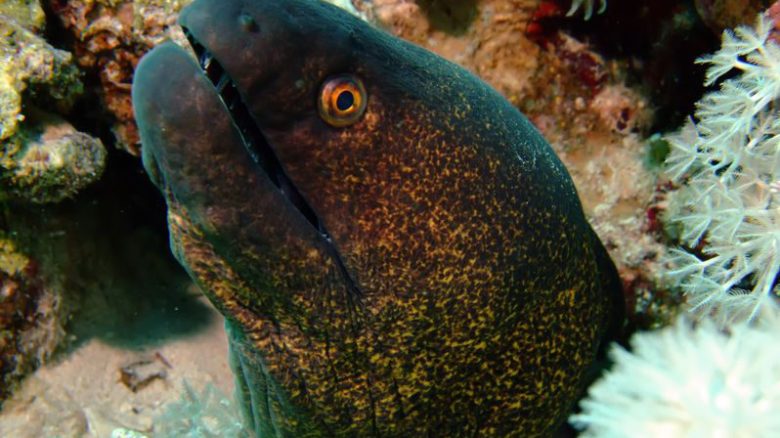The eels at Molokini are so cool! Each one is unique.
Because they spend a lot of time in reef dens, eels can be hard to find when you are out snorkeling Molokini Crater. The moment you do see one, though, you’ll know the search was worth it! Brush up on your eel knowledge now, so you’ll know which type you’re seeing when you see it.

Seen above is the yellowmargin moray eel.
Okinawan Moray
The Okinawan moray eels can wiggle into the smallest of crevices because, unlike most other morays, they lack a prominent dorsal fin. These morays are carnivorous, eating crustaceans, octopus, squid, and tiny fish.
Dwarf Moray
Unlike the zebra moray which eat sea urchins, the pencil-sized dwarf moray hang out with sea urchins for their protection. One of the smaller eels, the dwarf gets up to 26 cm in length, and is a carnivorous species.
Zebra Moray
The zebra moray use their little teeth to crush their prey. They feed on crustaceans, sea urchins, and mollusks. Some favorite foods are snails and crabs. Zebra moray get their name from their band of dark and white stripes. They can be found in the Indo-Pacific, Red Sea, and the Galapagos, apart from Molokini and the main Hawaiian islands.
Garden Eel
The big eyes of garden eels help them see their food, which is tiny plankton. If threatened, the garden eels burrow themselves back into the sand. Garden eels can be spotted on Molokini, as well as the Caribbean, Atlantic, Indo-Pacific, and East Pacific. Living in groups, they appear as a bed of sea plants, which is how they get their name.
Snowflake Moray (Puhi Kapa)
One of the few eels that can be spotted during the day, the snowflake moray eel is colorfully spotted and has a long, thin body. It preys upon crabs and fish. In addition to Molokini and the main Hawaiian islands, snowflake morays can be found in the Red Sea, Costa Rica, Micronesia, California, Mexico, and Columbia.
Yellowmargin Moray (Puhi Paka)
During the day, the puhi paka poke their heads out of the Molokini coral, but during the night they swim across the reef, searching for dinner. One of the most territorial eels, these moray can even be seen with battle cuts. Although they are known to be threatening to divers, in fact they will only display aggressive behavior when provoked. To breathe, morays open and close their mouths, pushing water through their gills.
Yellow-Spotted Snake Eel
These eels push their heads above the sand and pump water across their gills, but then retreat beneath the sand when threatened, digging backwards. Yellow-spotted snake eels are found in depths of 4 to 24 meters on Molokini as well as the main Hawaiian islands, Midway Island, and the French Frigate Shoals.
Conger Eel
The spotted conger eel looks almost like it has leopard spots. Until 1989, only 5 conger eels were ever recorded throughout the world – two in Hawai’i, one in Indonesia, one in Madagascar, and another in Tahiti. They withdraw into the sand at the sight of predators, and swim in the open at night seeking their prey, which are small fish. Because this eels is nocturnal, it is very rare to see one during the day. In Japan, conger eel is on the menu at sushi restaurants.
Henshaw Eel
The Henshaw eel is practically invisible. In the daytime, only the tip of its nose sticks out of the sand. At night, it lets its whole neck and head protrude. The Henshaw eel attacks its prey with its sharp teeth, dragging prey under the sand, and swallowing them whole. Henshaw males reach a maximum length of 40 inches. These eels were named after Henry W. Henshaw, an ornithologist.
